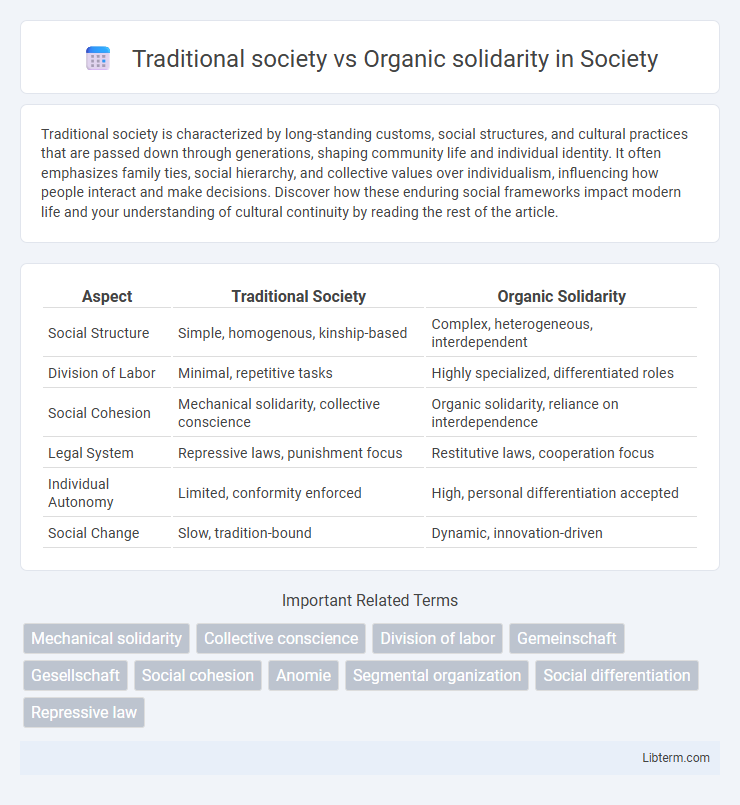Traditional society is characterized by long-standing customs, social structures, and cultural practices that are passed down through generations, shaping community life and individual identity. It often emphasizes family ties, social hierarchy, and collective values over individualism, influencing how people interact and make decisions. Discover how these enduring social frameworks impact modern life and your understanding of cultural continuity by reading the rest of the article.
Table of Comparison
| Aspect | Traditional Society | Organic Solidarity |
|---|---|---|
| Social Structure | Simple, homogenous, kinship-based | Complex, heterogeneous, interdependent |
| Division of Labor | Minimal, repetitive tasks | Highly specialized, differentiated roles |
| Social Cohesion | Mechanical solidarity, collective conscience | Organic solidarity, reliance on interdependence |
| Legal System | Repressive laws, punishment focus | Restitutive laws, cooperation focus |
| Individual Autonomy | Limited, conformity enforced | High, personal differentiation accepted |
| Social Change | Slow, tradition-bound | Dynamic, innovation-driven |
Defining Traditional Society
Traditional society is characterized by close-knit communities where social cohesion arises from shared beliefs, customs, and values, often rooted in kinship and agricultural economies. It operates on mechanical solidarity, where individuals perform similar tasks and roles, fostering collective conscience and uniformity. This contrasts sharply with organic solidarity, typical of modern societies, where social cohesion depends on the interdependence of specialized roles and complex division of labor.
Understanding Organic Solidarity
Organic solidarity, conceptualized by Emile Durkheim, emerges in complex, industrial societies characterized by a high division of labor and interdependence among individuals performing specialized roles. Unlike traditional societies bound by mechanical solidarity through shared beliefs and homogeneity, organic solidarity relies on the differentiation and cooperation of diverse social functions to maintain social cohesion. This form of social integration fosters mutual reliance, enabling societies to adapt and function efficiently amidst increasing complexity and individualism.
Historical Context and Evolution
Traditional society, characterized by mechanical solidarity, relies on shared beliefs, values, and collective conscience to maintain social cohesion, prevalent during pre-industrial eras with limited division of labor. Organic solidarity emerges in modern, industrial societies with complex division of labor, fostering interdependence among individuals performing specialized roles. Historical evolution from traditional to organic solidarity reflects societal transformation due to industrialization, urbanization, and increased social differentiation.
Key Features of Traditional Societies
Traditional societies are characterized by close-knit, homogeneous communities with strong kinship ties and shared values rooted in agriculture and subsistence economies. Social cohesion is maintained through mechanical solidarity, where individuals perform similar roles and collective consciousness dominates. Custom, tradition, and rigid social hierarchies guide behavior, limiting social mobility and emphasizing conformity.
Main Characteristics of Organic Solidarity
Organic solidarity is characterized by a complex division of labor where individuals perform specialized roles, fostering interdependence within society. Social cohesion arises from the necessity of cooperation among diverse functions, rather than shared beliefs or similarities. This form of solidarity is typical in modern industrial societies with greater social differentiation and individual autonomy.
Social Structure and Organization
Traditional society is characterized by mechanical solidarity, where social structure is based on homogeneity, shared values, and collective conscience that bind individuals through kinship and community ties. Organic solidarity emerges in modern, complex societies with a social structure founded on specialization and interdependence, where individuals perform diverse roles contributing to a cohesive whole despite differences. The organization in traditional societies relies on rigid hierarchical roles and strong social cohesion, whereas organic solidarity depends on contractual relationships and functional differentiation within institutions.
Roles, Norms, and Social Control
Traditional society relies on mechanical solidarity, where roles are rigid, norms are collective and homogeneous, and social control is enforced through strong conformity to shared beliefs and customs. Organic solidarity, characteristic of modern industrial societies, features differentiated and interdependent roles, diverse and specialized norms, and social control exercised through formal laws and institutional regulations. The transition reflects a shift from repressive sanctions to restitutive mechanisms, emphasizing individual autonomy within a complex social structure.
Cohesion and Collective Consciousness
Traditional society exhibits strong cohesion through mechanical solidarity, where collective consciousness is homogenous, shared beliefs and values create social unity. Organic solidarity characterizes modern societies with diverse roles and interdependence, where cohesion arises from the reliance on specialized functions despite a more fragmented collective consciousness. The shift from mechanical to organic solidarity reflects changes in social cohesion mechanisms and the complexity of collective consciousness.
Impact of Modernization and Industrialization
Traditional societies rely on mechanical solidarity characterized by homogeneity and strong collective conscience, which diminishes as modernization and industrialization introduce diversification of labor and individualism. Organic solidarity emerges in complex industrialized societies where social cohesion is maintained through interdependence of specialized roles, fostering increased social differentiation and cooperation. The impact of modernization drives the transition from collective uniformity to functional interdependence, reshaping social structures and weakening traditional ties.
Comparative Analysis: Traditional Society vs. Organic Solidarity
Traditional society relies on mechanical solidarity, characterized by homogeneity, shared values, and strong collective conscience that maintains social cohesion through similarities among members. Organic solidarity emerges in complex, modern societies where social cohesion is based on interdependence and specialization of roles, fostering cooperation despite individual differences. Comparative analysis reveals traditional societies emphasize uniformity and collective norms, whereas organic solidarity supports diversity and functional differentiation for social integration.
Traditional society Infographic

 libterm.com
libterm.com